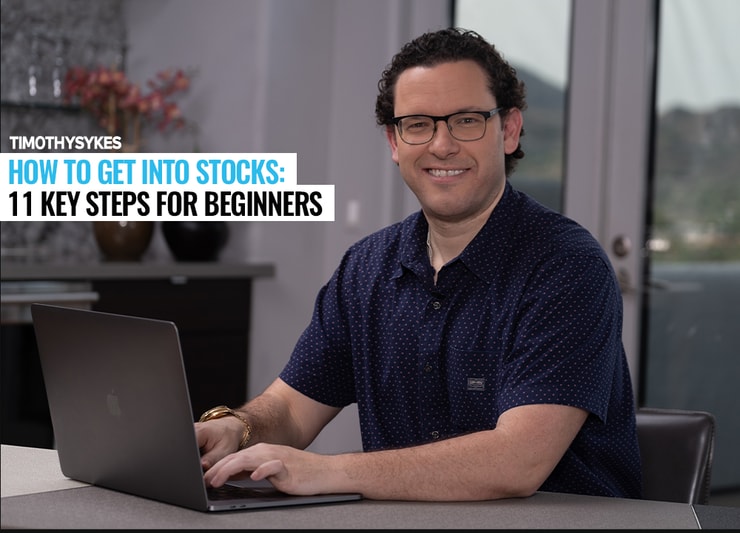Just because getting into the stock market is logistically simple doesn’t mean it’s easy to be good at trading. So let’s look at how to get into stocks and the stock market.
First, the good news: It’s actually pretty easy to become a trader. You don’t need special degrees or certifications. All you need is a brokerage account, a laptop, and a stable internet connection.
But those are just the technical requirements.
Getting to the point where you can potentially profit in the stock market requires a lot of hard work and dedication. You need to get in the right mindset, understand how the market works, and learn how to execute trades well.
So let’s talk about how to get into stocks right now as a beginner…
Table of Contents
- 1 What Is Stock Market Trading?
- 2 How to Get Into the Stock Market
- 2.1 1. Lose Some Money and Learn From Your Mistakes
- 2.2 2. Do Some Fact-Finding
- 2.3 3. Listen and Learn
- 2.4 4. Join My Trading Challenge
- 2.5 5. Study Obsessively
- 2.6 6. Paper Trade
- 2.7 7. Focus on Some Key Setups
- 2.8 8. Go Slow
- 2.9 9. Learn From Your Mistakes
- 2.10 10. Learn From Other Traders
- 2.11 11. Expand Your Knowledge Base
- 3 How to Trade Stocks and Get Into the Stock Market: 4 Steps For Beginners
- 4 Frequently Asked Questions About How to Get Into Stocks
- 5 The Bottom Line About Getting Into the Stock Market
What Is Stock Market Trading?
Stock market trading is when a trader buys and sells stocks with the aim of making a profit. Stock traders look to profit in the short term. That’s how trading and investing are different.
Investing is usually a long-term hold in a company’s stock. Trading is quite the opposite…
As a trader, I’m constantly adapting to market conditions and following patterns and trends. I watch for price action and high volume. Investors usually buy a stock and hold it for years. They aren’t constantly watching for indicators that might move a stock like I am.
I’m not saying that investing is easy. I’m just talking about being a good trader … It’s hard work that requires a lot of knowledge about the markets. So, if you’re dedicated and ready to study like you never have before, read on…
Now that I’ve given you some sage market advice, I’ll give you some specific steps to show you how to get into stock trading.
To help you better understand stock market trading, let’s go over a few basics … and when you’re ready for more, check out key stock terms here.
What Is a Stock?

A stock (also known as equity) is a share of ownership in a company. If you own a share or shares of a company’s stock, you have certain claims to the company’s earnings and assets.
Buying and Selling Stock
Shares of stock are represented by stock certificates, which are legal documents. It used to be that you’d receive physical certificates that you’d take to a broker to sell.
These days, most trading is conducted online, and your broker holds your certificates electronically. Brokers can quickly facilitate purchases and sales. Again, this is usually done online.
More Breaking News
- Canaan’s Surging Stock: Analyzing Its Recent Rise and Potential Future
- Joby Aviation: Is It Flying High or About to Land?
- Is AMD Riding the Wave of AI and Cloud Innovations?
Stock Exchanges
Stock exchanges are where traders and investors can buy and sell stocks. These exchanges provide volume and liquidity in addition to a place where stock transactions can be conducted.
You’re probably familiar with the big exchanges like the New York Stock Exchange (NYSE), American Stock Exchange (AMEX), and the Nasdaq. But for penny stocks, which are what I primarily trade, you’ll look more at smaller markets like the over-the-counter (OTC) markets.
How to Get Into the Stock Market

Want to know how to get into the stock market? First, get your head in the right place.
Here are some things I wish a mentor had told me before I got started…
1. Lose Some Money and Learn From Your Mistakes
If you want to learn how to get into stocks, you need to lose some money first. I’m only half joking.
A lot of people who apply to my Trading Challenge find me because they’ve lost money. They tried trading alone, with no knowledge or preparation. And they’ve seen what it’s like to trade based on solely their gut instincts. The results usually aren’t pretty.
The good news? Losing money can be a powerful motivator. The humbling experience can make some traders appreciate the power of knowledge. You know the saying: Knowledge is power.
You’ll make mistakes … no matter your trading experience. So if you want to learn how to get into stocks, be prepared to lose. I still lose in trades. But I try to keep my losses small and learn from my mistakes.
Keeping a trading journal is key. It’s how you can track your mistakes and successes. As you review it over time, you can find patterns in your own trading to help you trade smarter. You’ll see what your trading strategies are.
2. Do Some Fact-Finding
If you want to learn how to get into stocks, start with a fact-finding mission. Search online for good information about day trading, penny stock trading, and any other facets of trading that might interest you.
A great place to start is with my free online guide to penny stocks. It’ll show you some of the basics.
As you do your fact-finding, be careful who you listen to. There are a lot of fakes in this industry.
3. Listen and Learn
The stock market is all about strategy. Without a plan, you’re basically gambling.
To make smart trades, you have to study, research, and make solid plans. This typically starts with building a watchlist and then narrowing down your choices. Next, it’s time to analyze.
You could start with fundamental analysis … That’s how you evaluate a company’s performance by looking at things like earnings, press releases, and financials. You can find clues on catalysts that could affect a stock’s price.
There are lots of different ways to listen and learn. Keep reading to learn about some more…
4. Join My Trading Challenge
Let’s be clear: I don’t accept just anyone into my Trading Challenge. I have enough students. Now I only want to work with people who are dedicated.
When I started trading, I didn’t have a mentor. I was ultimately successful, but not because it was easy. I made money because I worked my butt off for it. But I had little guidance and made plenty of mistakes because of it. Since I was obsessive, eventually I found my way.
My motivation as a teacher is to be the mentor I never had. I want to give other traders the benefit of learning from my mistakes and potentially avoiding them.
My Challenge includes lessons, live webinars from me and my top students, blog posts, and more.
It also includes trading. Ready to dive in and start taking small positions? I’m right there with you. Each year, I start trading with a small account so I can show everyone what’s possible. It’s also why I show every trade publicly on Profit.ly.
Up for the Challenge? Apply today.
5. Study Obsessively
If you want to trade, you need strong study habits to learn how to do research and build your knowledge base. A big knowledge account may spill over into a big brokerage account.
If you’re accepted into my Trading Challenge, you can watch all my videos and read through the study materials.
You should also study stock charts independently. Even if you’re not trading yet, looking at stock charts can help you find patterns. It’ll serve you well as a trader.
6. Paper Trade
For many people, paper trading is a powerful first step toward making actual trades.
Paper trading, or virtual trading, closely mimics the look and feel of live trading. But you don’t risk actual money.
It’s a way to practice trades without actually investing your money. Sure, it might not come with the adrenaline high of trading real money, but it’s a safe way to get a feel for the process.
Making mistakes with virtual cash is easier than doing it with real money. I recommend the StocksToTrade paper trading platform. You can get a 14-day StocksToTrade trial today for only $7.
Full disclosure, I helped develop StocksToTrade, and I’m an investor. That’s why I’m psyched to share its paper trading platform and all its other great features.
7. Focus on Some Key Setups
Learning how to get into stocks can be overwhelming. Start slow, and focus on just a few things at a time. Instead of scattering your attention in a million directions, zero in on a few key setups.
In my Trading Challenge, I go over key setups and patterns. It takes time to master patterns.
That’s why it’s smart to start with paper trading first. You get a sense of how trades and patterns play out without risking your hard-earned cash. Then you can work on progressing to real trading.
By focusing on a few key setups, you can refine your methods.
8. Go Slow
A lot of people who are drawn to day trading have a very black-and-white view of the world. That can be good if you’re willing to use your analytical attitude for in-depth research on stocks and obsessively watching for patterns.
But if you’re expecting to get rich quick, think again. Don’t come into day trading with the idea that you’ll become an instant millionaire. You’ll most likely get crushed. Like most things in life, becoming a great trader takes time.
It won’t click overnight. You need to take a slow, steady approach to trading.
One tip on how to get into stocks? Adjust your expectations. There will be a lot of ups and downs as you develop a trading style.
Again, if you expect to make money right away, you’ll likely end up disappointed. Give yourself time to develop and grow by going slow.
9. Learn From Your Mistakes
I mentioned earlier how trading penny stocks won’t always result in wins. After 20+ years of trading, I still lose sometimes. Every trader does. Get used to it…
You need to learn from your mistakes. Mistakes can be among the most powerful learning tools. Some of my top students didn’t become profitable traders until after they took big losses.
I’m not saying that you should just go and take a big loss — but you need to use every loss to your advantage. Good traders learn from their wins AND losses. Bad traders are losers because they only look at their winning trades.
10. Learn From Other Traders
This can be gold if you want to learn how to get into stocks and stay there: Learn all you can from other traders.
Find a mentor you can learn from. Watch what other traders do and learn from their successes (and failures). It can help inspire your own trading.
Let me be clear … observing is not the same as copying or following other traders blindly.
That’ll never work out well. There are too many factors involved, and you can never emulate someone completely. By the time you copy someone else’s trade, you’re already behind the curve.
You need to figure out your own style.
But seeing other trading styles can inform and motivate you on your journey.
11. Expand Your Knowledge Base
You have to continually expand your knowledge base if you want to stay relevant. So if you’re asking how to get into stocks, this is key.
You have to keep up with the news, learn how to read financial reports, and know which setups work best for you in different market conditions. The market’s always changing. To stay on top, you have to adapt your trading to match it.
So keep reading. Watch my videos. Listen to podcasts. If you make all this a daily habit, it can serve you well as a trader for years to come.
How to Trade Stocks and Get Into the Stock
Market: 4 Steps For Beginners

Curious about the best way to get started in the stock market? Since a lot of new traders are starting with small accounts, it’s important to make the most of every trade.
At the same time, as a new trader, you want to focus on small gains. Don’t take huge positions in trades. Remember, small gains add up over time. Trading is a marathon, not a sprint!
Day trading and investing used to be reserved for the wealthy. They’d have a broker to execute their trades and invest their money.
Now, with the internet and online commission-free brokerages, it’s possible to get into the market with very little money. Just about anyone can open an account and start buying and selling stocks. Even from a smartphone.
Online brokerages have made it easy for beginners to get into the stock market and manage their own money. There are even brokerages with no minimum deposit requirement. You could even start trading with $100 (although I don’t recommend that).
Later in this post, I’ll explain why I believe trading penny stocks is the best way to grow a small account. But let’s start at the beginning…
How to Get Into Stocks Tip #1. Open a Brokerage Account
To actually place market orders and execute trades, you’ll need a brokerage account.
Do your research and choose a good broker for you. This is how you’ll execute trades. You don’t want to be surprised to learn that you’re paying more fees or higher percentages than you thought.
Take the time to research the different options out there and choose the best one to suit your style. Some of the top brokers I recommended to beginners are Interactive Brokers, E-Trade, and TD Ameritrade. There are lots more though so do your research before choosing one.
Choosing the Right One
This isn’t a one-size-fits-all model. The right broker for you will depend on things like how much money you have to trade, your trading style, the tools you’re looking for, and so on.
For example, If you are a short-biased trader you might want to stay away from TD Ameritrade. They are a good brokerage for long-biased traders, but not necessarily short-biased ones.
There are lots of things to take into account when choosing a broker. Read “The Complete Penny Stock Course” to find out more about what you need to take into consideration when selecting a brokerage.
How to Get Into Stocks Tip #2. Penny Stocks: Smart Trading With a Small Account
I think the best and most accessible way to grow a small account is through trading low-priced stocks, aka penny stocks. But you need a good strategy and rules.
Penny stocks don’t always sell for literal pennies. These are stocks that trade for $5 or less per share.
While the penny stock market is notoriously volatile, its rapid fluctuations can mean opportunities for fast gains.
Penny stocks are how I made my fortune in the stock market.* And they’re the primary focus of my teaching. I think that they offer great opportunities for everyday traders, particularly anyone willing to work hard. Even if they’re starting with small accounts.
(*These results are not typical. Individual results will vary. Most traders lose money. My top students have the benefit of many years of hard work and dedication. Trading is inherently risky. Always do your due diligence and never risk more than you can afford to lose.)
Penny Stocks
The finance world loves to look down on penny stocks. When I tell people I trade penny stocks they usually laugh. What they don’t know is that I’m glad they laugh about it.
It leaves a lot of room for ordinary people like you and me to be successful.
My top students and I aren’t the smartest people ever. But we aren’t dumb either. We’ve made millions because we have discipline, know how to read charts, and learn patterns.*
Not to be rude, but I’ve taught some unintelligent people. And they’ve learned my patterns and worked to become successful traders. If we can do it, I believe anyone can.* As long as they put in the time and dedication.
How to Get Into Stocks Tip #3. Key Strategies
There are certain strategies in day trading that everyone should try to master. It could just change your trading forever…
Technical Analysis
Here you focus on the actual stock’s performance.
With technical analysis, you look at historical data to review the stock’s performance over time. You’re looking for past trends that could inform what the stock will do in the future.
Here’s what to look for:
- The price action or how the stock price moves over time. For instance, does it have a history of gaining?
- Price trends or predictable spikes or dips. Check for trends on multiple charts.
- Patterns. When a stock moves in a particular way, it can repeat that action pretty closely in the future. So, when you look at a stock’s performance over time, look for patterns.
Key Chart Patterns
Over the years, I’ve identified key chart patterns that I depend on and look for when seeking out trades.
One of my favorites is what I call the supernova. I named it after supernovas in space, which have a big explosion and then fizzle out.
An explosion in a stock’s price creates many opportunities for traders. You can buy as the stock soars in price or short sell on its way back down (some traders do both).
While that’s one of my favorite patterns, it’s far from the only one out there. In my free penny stock guide, I cover more patterns in greater detail.
How to Get Into Stocks Tip #4. Never Stop Learning
A continued dedication to learning is essential for traders. As William S. Burroughs once said, “When you stop growing you start dying.”
Continuing to learn will help you adapt to market shifts and changes. When the market changes and your go-to setups don’t work anymore, having a large knowledge base can help you adjust.
It’s why maintaining a trading journal is smart. You can keep track of your own patterns as a trader and learn from your past experiences.
Keep growing in every way you can. Read, watch videos, and absorb everything you can about trading, techniques, tips, and trading strategies.
Matthew Monaco and I put together the 30-Day Bootcamp. This Bootcamp includes trading lessons I’ve learned in my 20+ years of trading. And it has the best reviews out of all of my products. Get in my Bootcamp today to start building your trading foundation.
Trading Challenge
I can’t say it enough. The Trading Challenge can help you so much as a trader!
I want you to understand how important it is to me and my top students.
I consider the Trading Challenge chat room to be the best chat room out there. I know I’m a little biased, but I’m inspired by my students all the time. Apply to join my Challenge and find out just how great this community is … And get access to all the resources I’ve put together in 10+ years of teaching.
Frequently Asked Questions About How to Get Into Stocks

How Do Beginners Get Into the Stock Market?
The short answer here is to create a brokerage account and start trading securities. However, the smarter thing to do is study up and learn as much as you can about stocks before risking your hard-earned cash.
How Do I Start Studying Stocks?
There are lots of resources for beginners to learn about stocks. I have lots of blog posts, webinars, books, YouTube videos, and more to help you study stocks and the market. It’s also important to watch stocks on your own time. Set aside time each day to watch individual stocks and the market as a whole.
How Can I Make Good Money From Stocks?
There’s no secret recipe that will help make you money in the stock market. The best way to approach trading is to put in time and dedication for studying, preparation, and practice on a regular schedule. Your reward for all that hard work? Becoming a self-sufficient trader who can learn to adapt to any kind of market.
How to Trade Stocks With Little Money
Ask yourself, “how much money am I willing to use?” Never risk more than you’re willing to lose. Once you understand this, you can put in the time studying to learn a trading strategy that will work for you no matter your account size.
What Are the Best Stocks to Buy for Beginners?
That’s the wrong mindset for newbie traders. First, you need a strategy and trading plan. After practicing with paper trading, focus on the biggest daily movers with volume and a catalyst. Volatility can be your friend. Of course, make sure to weigh your risk/reward before every trade.
The Bottom Line About Getting Into the Stock Market

Still ready to learn more about how to get into stocks? The stock market is trickier than it might seem from the outset. Yes, the entry is extremely easy and requires little equipment.
But to become an intelligent, self-sufficient trader takes time and effort. That part isn’t easy … You’ll have to consider many different things, expand your mind, and work hard. But it can be worthwhile.
There are so many resources out there that can help you learn to be a better trader. Take advantage of them. It’ll help speed up your learning curve and ultimately make you a better trader.
What else do you need to learn to get into stocks? Are you ready to enter the stock market? Let me know in the comments … I love to hear from my readers.







Leave a reply